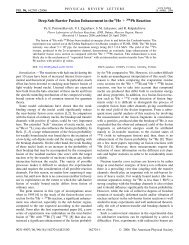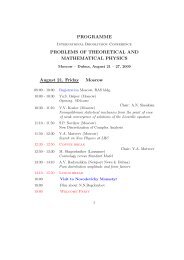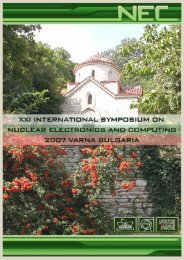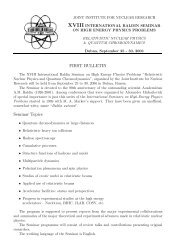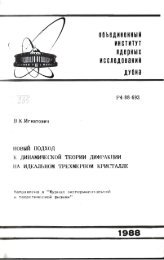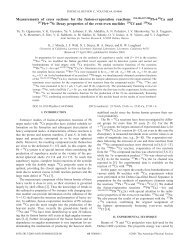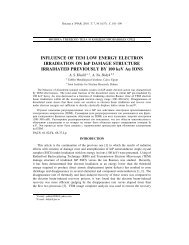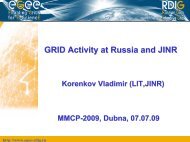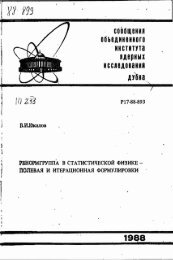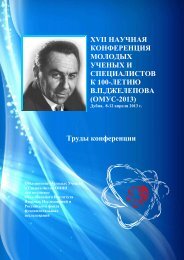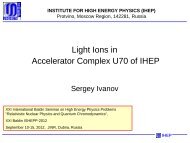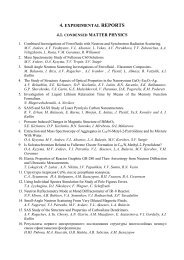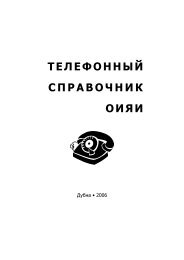Joint Institute for Nuclear Research Relativistic ... - Index of - JINR
Joint Institute for Nuclear Research Relativistic ... - Index of - JINR
Joint Institute for Nuclear Research Relativistic ... - Index of - JINR
Create successful ePaper yourself
Turn your PDF publications into a flip-book with our unique Google optimized e-Paper software.
ADIABATIC CHEMICAL FREEZE-OUT AND WIDE RESONANCE<br />
MODIFICATION IN A THERMAL MEDIA<br />
K.A. Bugaev 1† , D.R. Oliinychenko 2 , E.G. Nikonov 3 , A.S. Sorin 2 and G.M. Zinovjev 1<br />
(1) Bogolyubov <strong>Institute</strong> <strong>for</strong> Theoretical Physics, Metrologichna str. 14 B , Kiev 03680, Ukraine<br />
(2) Bogoliubov Laboratory <strong>of</strong> Theoretical Physics, <strong>JINR</strong>, Joliot-Curie str. 6, Dubna, Russia<br />
(3) Laboratory <strong>for</strong> In<strong>for</strong>mation Technologies, <strong>JINR</strong>, Joliot-Curie str. 6, 141980 Dubna, Russia<br />
† E-mail: Bugaev@th.physik.uni-frankfurt.de<br />
The hadron resonance gas model [1] is a reliable theoretical tool to extract in<strong>for</strong>mation<br />
about the chemical freeze-out (FO) stage <strong>of</strong> the relativistic heavy ion collisions. However,<br />
the question about the reliable chemical FO criterion has a long history [1, 2]. Very<br />
recently this question was thoroughly investigated again [2], using the most sophisticated<br />
version <strong>of</strong> the hadron resonance gas model. Similarly to [1] it was found that none <strong>of</strong><br />
the <strong>for</strong>merly suggested chemical FO criteria is robust, if the realistic particle table with<br />
the hadron masses up to 2.6 GeV is used. However, in [2] the criterion <strong>of</strong> the adiabatic<br />
chemical FO was suggested. In [2] it was also shown that despite an essential difference<br />
with the model <strong>of</strong> [1] the same conclusion on the constant entropy per particle at chemical<br />
FO is reproduced by the chemical FO parameters found in [1]. Thus, it turns out that<br />
the criterion <strong>of</strong> the constant entropy per particle at chemical FO is, indeed, the reliable<br />
one.<br />
Despite the long history <strong>of</strong> this question there was no a single try to understand what<br />
is the physical reason behind any <strong>of</strong> the chemical FO criterion. There<strong>for</strong>e we developed<br />
a simple model equation <strong>of</strong> state which not only well describes the chemical FO thermodynamic<br />
parameters and reproduces the constant value <strong>of</strong> the entropy per particle at<br />
the chemical FO, but which allows us to elucidate the real mass spectra <strong>of</strong> mesons and<br />
baryons that generate such a criterion. Our analysis demonstrates that the real mass<br />
spectrum <strong>of</strong> hadrons is very much different from the Hagedorn mass spectrum which is<br />
traditionally expected to emerge already <strong>for</strong> hadrons with masses above 1.2 GeV [3]. We<br />
argue that the real mass spectrum <strong>of</strong> hadrons is not an exponential, but a power-like<br />
and the reason <strong>for</strong> such a behavior is in the existence <strong>of</strong> many wide resonances. The<br />
main point is that that the presence <strong>of</strong> thermal media essentially modifies the resonance<br />
mass distribution in case <strong>of</strong> large width and leads to the resonance sharpening near the<br />
threshold. The related effect <strong>of</strong> wide resonance enhancement compared to their treatment<br />
as stable particles with the average resonance mass is also discussed. Both effects are<br />
demonstrated in Fig. 2. Based on these findings we suggest that the quark-gluon bags<br />
maybe observed at the NICA energies as the narrow resonances with mass between 2.5<br />
and 4 GeV which are absent in the tables <strong>of</strong> elementary particle properties.<br />
Contacting the non-relativistic Boltzmann distribution in resonance energy φ(m,T) ≃<br />
[ mT<br />
2π 2 ]3<br />
2<br />
exp [ − m T<br />
]<br />
with the cut Gaussian distribution Θ<br />
(<br />
m−M<br />
Th<br />
k<br />
) ]<br />
exp<br />
[− (m k−m) 2<br />
over<br />
the resonance mass m one can easily see that the maximum <strong>of</strong> the resulting mass distribution<br />
is located at m = ˜m k ≡ m k − σ2 k<br />
T<br />
<strong>for</strong> k-th resonance. In addition, the resonance<br />
degeneracy factor g k is changed to an effective value ˜g k = g k exp[<br />
σ 2<br />
k<br />
2T 2 ]. Here m k denotes<br />
the mean mass <strong>of</strong> the resonance k-th in a vacuum, while its Gaussian width in a vacuum is<br />
σ k (note that thetrue width <strong>of</strong> such a resonance is Γ k = Qσ k with Q ≡ 2 √ 2 ln2 ≈ 2.355).<br />
32<br />
2σ 2 k



